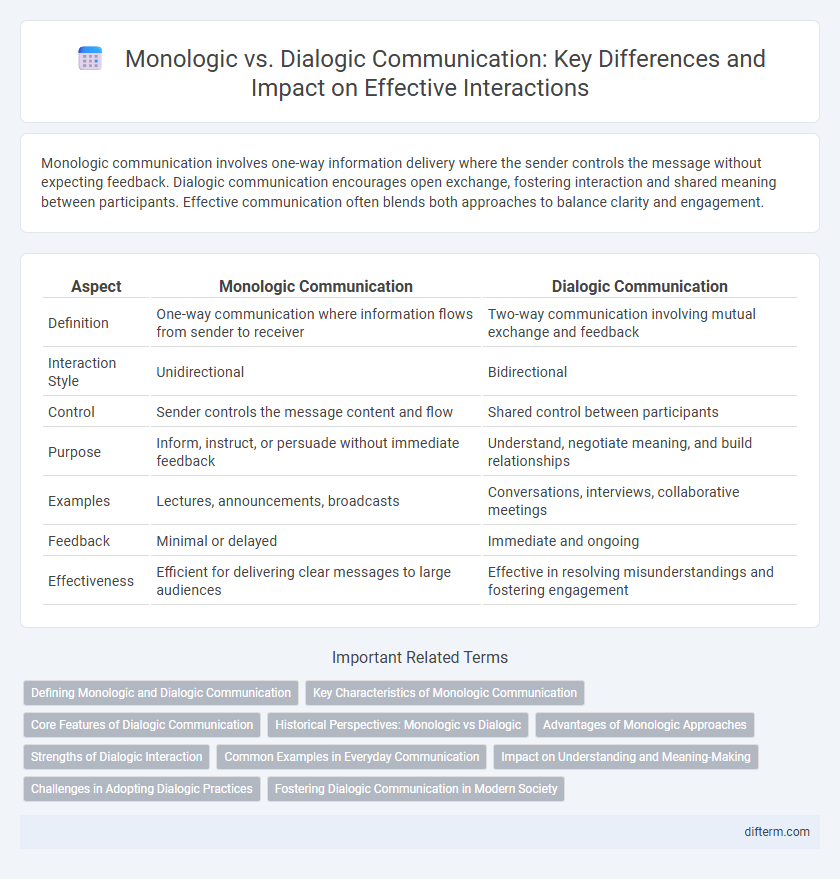Monologic communication involves one-way information delivery where the sender controls the message without expecting feedback. Dialogic communication encourages open exchange, fostering interaction and shared meaning between participants. Effective communication often blends both approaches to balance clarity and engagement.
Table of Comparison
| Aspect | Monologic Communication | Dialogic Communication |
|---|---|---|
| Definition | One-way communication where information flows from sender to receiver | Two-way communication involving mutual exchange and feedback |
| Interaction Style | Unidirectional | Bidirectional |
| Control | Sender controls the message content and flow | Shared control between participants |
| Purpose | Inform, instruct, or persuade without immediate feedback | Understand, negotiate meaning, and build relationships |
| Examples | Lectures, announcements, broadcasts | Conversations, interviews, collaborative meetings |
| Feedback | Minimal or delayed | Immediate and ongoing |
| Effectiveness | Efficient for delivering clear messages to large audiences | Effective in resolving misunderstandings and fostering engagement |
Defining Monologic and Dialogic Communication
Monologic communication involves a one-way exchange where the speaker transmits information without seeking feedback or interaction from the listener. Dialogic communication is a bidirectional process characterized by open, reciprocal dialogue that encourages active participation and mutual understanding. This contrast highlights monologic's emphasis on delivering messages versus dialogic's focus on collaborative meaning-making.
Key Characteristics of Monologic Communication
Monologic communication involves one-way transmission of information from the speaker to the listener without expecting immediate feedback or interaction. Key characteristics include dominance by a single voice, structured and controlled messages, and a focus on delivering a specific idea or argument clearly and persuasively. This style often appears in lectures, announcements, and formal speeches where interaction is minimal or nonexistent.
Core Features of Dialogic Communication
Dialogic communication centers on interactive, reciprocal exchanges that foster mutual understanding and co-creation of meaning between participants. Core features include active listening, collaborative dialogue, openness to diverse perspectives, and a dynamic flow that adapts to feedback in real time. Unlike monologic communication, dialogic processes emphasize relational depth and ongoing negotiation rather than one-way information transmission.
Historical Perspectives: Monologic vs Dialogic
Historical perspectives on communication distinguish monologic discourse as a one-way transmission of information, often seen in traditional lecturing and media broadcasts, while dialogic communication emphasizes two-way interaction and mutual understanding, rooted in Socratic dialogue and later humanistic theories. The evolution from monologic to dialogic models reflects shifts from authoritative knowledge dissemination toward participatory, conversational engagement. This transition highlights the growing importance of feedback, negotiation, and co-construction of meaning in contemporary communication theory.
Advantages of Monologic Approaches
Monologic communication ensures clear, consistent messaging by allowing a single source to control the narrative, reducing the risk of misinterpretation. It is highly efficient for delivering complex information quickly, as it eliminates the need for negotiation or consensus. This approach is advantageous in situations requiring authoritative guidance or when time-sensitive decisions must be communicated effectively.
Strengths of Dialogic Interaction
Dialogic interaction enhances communication by fostering mutual understanding and active participation, which leads to more dynamic and responsive exchanges. It allows for diverse perspectives to be shared, promoting creativity and collaborative problem-solving. The strengths of dialogic communication lie in its ability to build trust, deepen relationships, and adapt to the needs of all participants.
Common Examples in Everyday Communication
Monologic communication often occurs in lectures, speeches, or announcements where one person delivers information without expecting immediate feedback. Dialogic communication is common in everyday conversations, meetings, and interviews where participants actively engage, exchange ideas, and respond to each other. Understanding these communication styles improves interaction effectiveness in both personal and professional contexts.
Impact on Understanding and Meaning-Making
Monologic communication centers on a single perspective, often limiting the depth of understanding by restricting the exchange of ideas and reducing opportunities for collaborative meaning-making. Dialogic communication fosters interactive, two-way exchanges that enhance understanding through diverse viewpoints and shared interpretation. This dynamic engagement promotes deeper comprehension and co-creation of meaning, leading to more nuanced and context-rich communication outcomes.
Challenges in Adopting Dialogic Practices
Adopting dialogic practices faces challenges such as overcoming entrenched monologic communication habits that prioritize one-way information delivery. Organizations struggle with creating environments that encourage open, reciprocal dialogue, often hindered by hierarchical structures and fear of conflict. Facilitating genuine dialogic communication requires continuous effort to build trust, active listening skills, and a cultural shift toward valuing diverse perspectives.
Fostering Dialogic Communication in Modern Society
Fostering dialogic communication in modern society enhances mutual understanding and collaboration by encouraging open, two-way exchanges that prioritize active listening and empathy. Unlike monologic communication, which centers on one-sided information delivery, dialogic interaction promotes shared meaning and collective problem-solving. Emphasizing dialogic communication in digital platforms and community settings bridges cultural divides and supports democratic participation.
Monologic vs Dialogic Infographic

 difterm.com
difterm.com